Riverside High School Climate Council

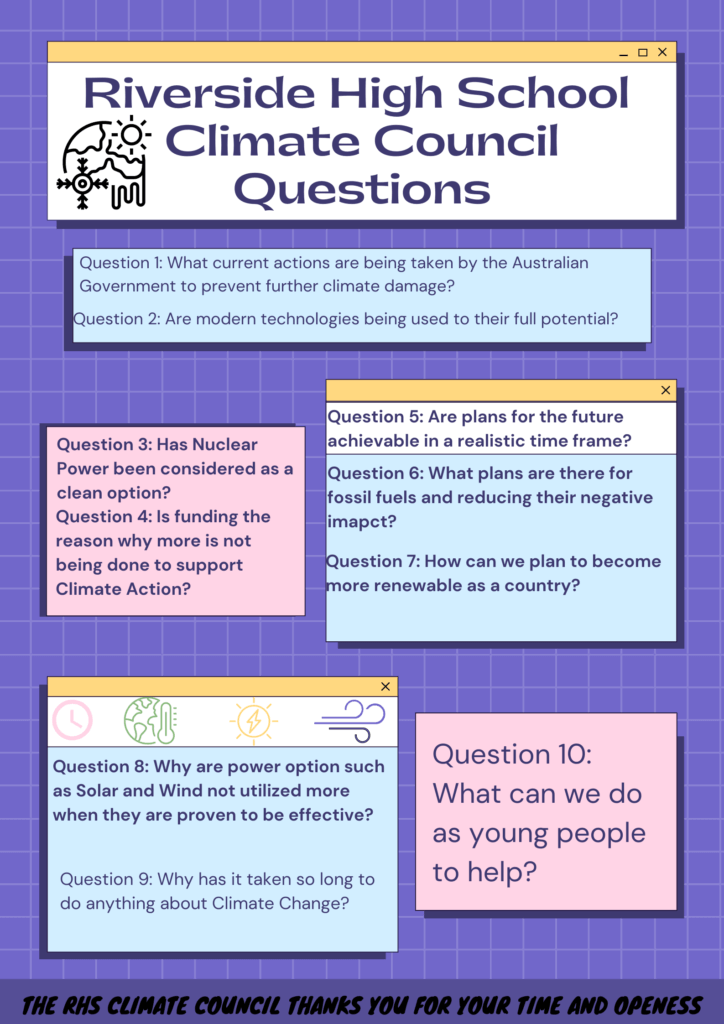
Hello hello Riverside Climate Council (what a wonderful student group you've got!)
Thank you for your questions about climate change. You asked some really interesting questions about technology, energy, taking action, and the future.
You'll find answers to your questions from our climate experts below - have a read and watch their answers.
You can also have a look at what other classes across Tasmania asked this year, as well as our climate change toolkit.
Our Questions
This is an excellent question, and one of the questions most students want an answer to. You can be someone who takes climate action!
Each of us can act individually (on our own) and collectively (together with others) to act on climate. We know, from scientific evidence, that climate change cannot be stopped and is happening already – but it can be reduced and slowed down. People today and into the future (including you) can make changes and decisions that will greatly reduce climate change and its impacts.
Some of these decisions are happening on a systemic scale - they the really big changes we need to reduce emissions from industries and electricity generation.
For example, world leaders are meeting together at COP26 (which is the UN Climate Change Conference of the Parties) to discuss pathways to do this – in particular, to ensure that global temperature rises do not exceed 1.5 degrees, and how we can adapt to climate change impacts into the future. If we can manage to greatly reduce global greenhouse gas emissions (such as carbon dioxide) we can limit climate change.
You might wonder how young people can influence big changes like this? By using your voices! Young people are involved in many groups and movements such as the School Strikes for Climate that have already made a difference to the way world leaders think about climate action.
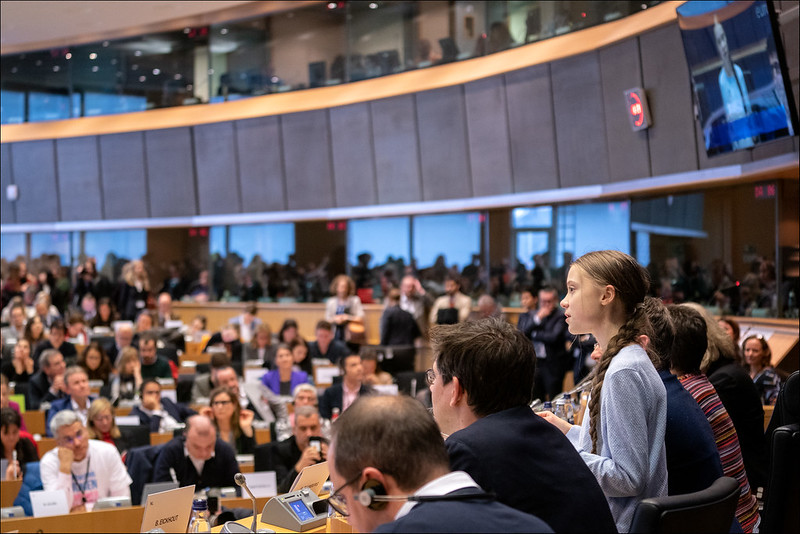
At a smaller scale, all of us can do something to make positive changes and have an impact on tackling climate change. Some people can do more and less than others, and that is OK - it’s great actually because lots of small changes can lead to big impact. In everyday life, there’s lot that you might be able to do, for example:
- You can aim to take the bus or walk, or ride your bike to school more.
- You could eat more vegetables, and eat meat less often (maybe even encourage your family and friends to have ‘meat free Mondays’?!). Plant-based foods generally produce fewer greenhouse gas emissions and they also require less energy, land, and water usage.
- You can speak up! Tell your friends and family about climate change and the small changes each of us can do to make a difference - remembering that we all have different abilities to make these changes, big and small.
There are a lot more ideas you can check out on our 'What can I do?' page.
This is such a good question, as it shows you are thinking about that fact that all sources of energy, whether renewable or non-renewable (like fossil fuels) have some emissions associated with them.
We all know well that fossil fuels are a real problem because of the large amounts of greenhouse gases they emit when burned. We can turn to renewable energy as an alternative – things like solar, wind and hydro. However, these technologies also have some carbon emissions associated with them. For example, if we think of a wind turbine, while the power it generates is low carbon, it’s not zero carbon. Carbon dioxide emissions are generated throughout a wind turbine’s life cycle, from mining the raw materials to build it, to its manufacture, construction, maintenance and also decommissioning at the end of the turbine’s “life”.
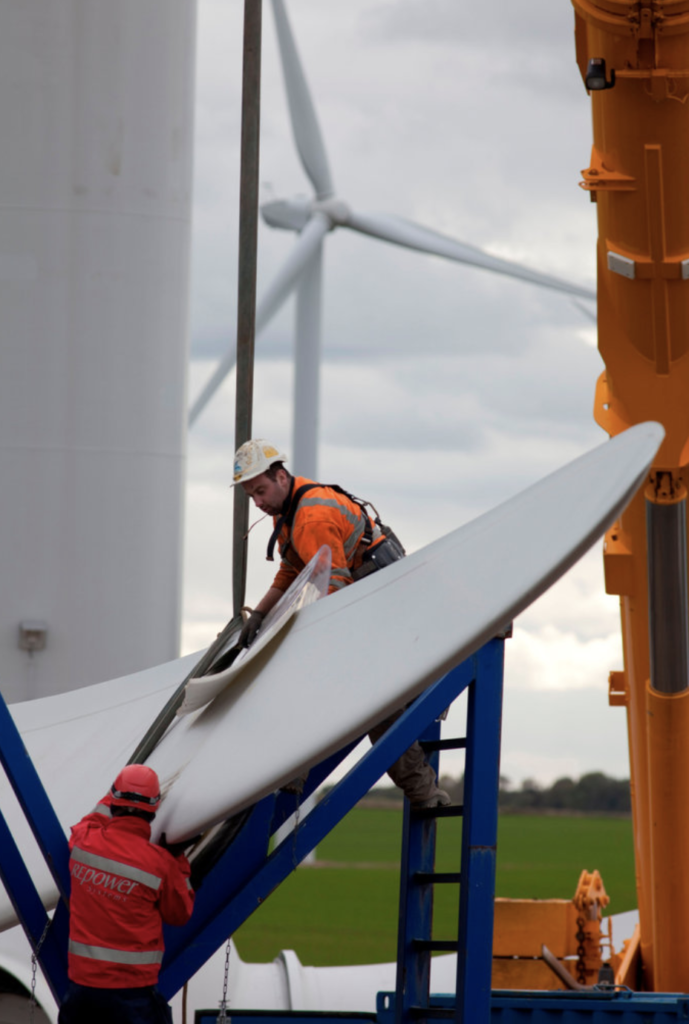
Did you know hydroelectric dams, particularly in tropical areas, can also have significant methane emissions associated with them, due to vegetation rotting under the dam’s water for several years after dams are first flooded? Methane is a powerful greenhouse gas, meaning that even hydroelectricity isn’t entirely “emissions free”.
Though no energy source is “perfect” in terms of carbon emissions, the carbon emissions associated with renewable energy sources over their life cycles are much, much lower than emissions from burning fossil fuels. In the near future, we may be able manufacture things like the steel for wind turbines not using fossil fuel but instead, using green hydrogen, making life cycle emissions of renewable energy sources even lower.
You asked about mitigating emissions from all energy sources: this is where the role of carbon sinks and offsets comes in. Even when we reach “net zero”, there will still be some emissions. Net zero means achieving an overall balance between greenhouse gas emissions produced, and greenhouse gas emissions taken out of the atmosphere, for example by trees and natural environments. When we are able to achieve that balance, then we will be doing really well – so that energy we consume in our daily lives won’t have a detrimental effect on our atmosphere and on the planet.
What an excellent and timely question: there has been a lot of discussion about nuclear power in the media recently. Also, Australia’s new plan to get to net zero emissions by 2050 does not rule out including nuclear power in this country’s future energy mix. So it’s an important time to be thinking and talking about nuclear.
Nuclear energy is used to generate electricity in 30 countries around the world, and provides about a tenth of the world’s energy needs. Nuclear power needs uranium, and the planet has uranium resources sufficient to fuel existing demand for more than 130 years. Nuclear power does not cause direct greenhouse gas emissions, which is good when we are thinking about climate change, however, the waste from nuclear power generation is problematic. It remains radioactive potentially for thousands of years and needs to be carefully stored under very controlled conditions in order not to pose a danger to humans and the environment.
Could Australia develop nuclear power? Currently the answer is no. That’s because Australian law currently prohibits the approval and construction of nuclear power plants and the enrichment of uranium needed for nuclear power. Could Australia develop nuclear power in the future as part of an effort to reduce greenhouse gas emissions? Australia does have a lot of uranium, in fact, it supplies about one third of the total world demand for uranium.
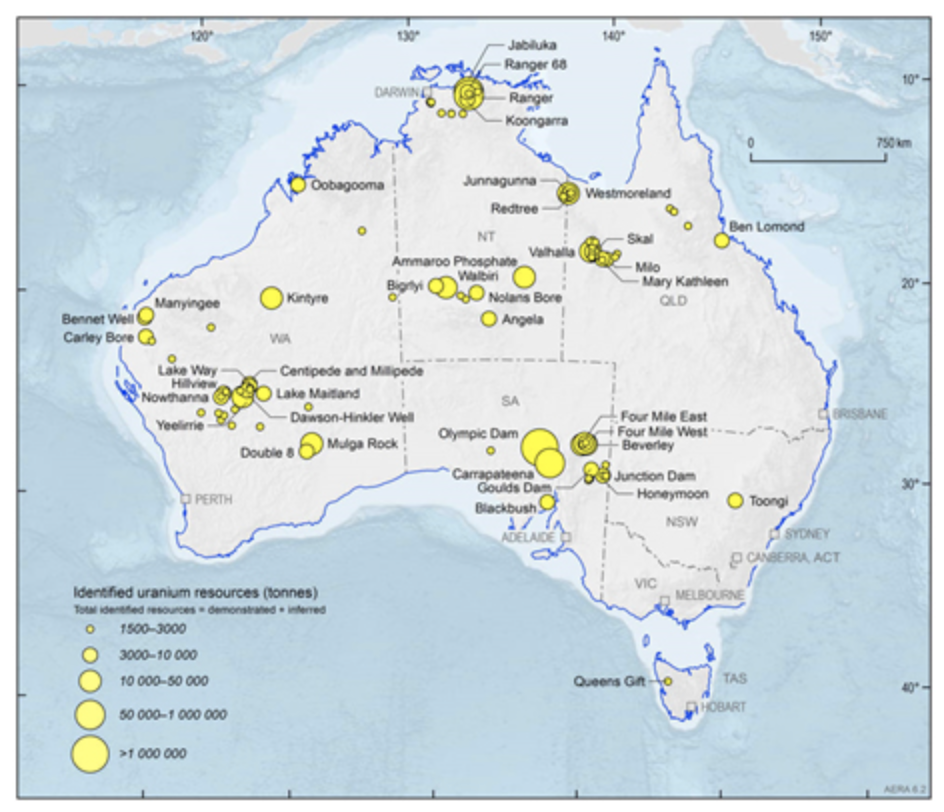
The problem with nuclear for Australia as part of the effort to reduce emissions this decade is quite simple: it’s too slow, and too expensive.
How is it too slow? The timeframe to build a nuclear power station is at least 10-12 years. If we started to build a nuclear power capacity in Australia right now (and remember, the law currently prohibits it) it would not be operational until the early-mid 2030s. Science tells us we need to cut emissions right now, this decade.
How is it too expensive? Despite our domestic reserves of uranium, nuclear is by far the most costly energy for Australia to generate, as you can see from the illustration below.

Comparison of power generation technology cost estimates. Source: CSIRO Gen Cost 2019-2020
If we were to build nuclear power capacity in Australia, starting today, the cost of renewables like wind and solar would be much less even than it is today by the time we were able to generate any nuclear power.
So we might pursue building nuclear power in Australia if we had no other alternatives, but we are lucky to have some of the most plentiful solar, wind and particularly offshore wind resources in the world. So renewables like wind and solar, backed up by hydroelectricity, batteries, and new fuels like green hydrogen, will be a faster and cheaper way to decarbonise than turning to nuclear power.
This is a very important question! The government play a key role in climate action by making laws and requirements that Australians across the country must abide by.
This year, the new government produced a Climate Act which includes the Australia’s first-ever national emissions target. The act means that the government commits to reducing 43% greenhouse gas emissions by a minimum of 43% by 2030 and to net zero by 2050. Even though a 43% target is not ambitious enough to avoid some major climate impacts – such as extreme floods, fires and droughts – this target can be increased over time and we hope it will be.
The Climate Act also says that the Minister for Climate Change and Energy (currently Chris Bowen) must present a climate change statement for Australia every year. This statement must take advice from the Climate Change Authority – who are a group of independent experts that provide advice to the Australian Government on climate change. This advice is important because it means that government decisions on climate change will be informed by expert knowledge on climate, and not just political views.
The government’s budget can also show us what actions and changes it is prioritising. Every government must outline how they will spend national money and where they will spend it - for example, on schools, hospitals, public transport, and everything else. Compared to previous governments, this new government has invested much more in actions for mitigating and curbing climate change, which is good news! For example, it has have promised $47.1m to the Climate Change Authority. It has also allocated $102.2m for a community solar banks program to improve access to clean energy for lots of communities, and $275m for electric vehicle charging stations to help speed up Australia’s transition from burning fossil fuel.
These are all great changes in Australia’s effort to take action on reducing climate impacts, but the government needs to continuing making changes and doing more if we are to reduce climate impacts here in Australia and across the world. Engage your local politicians - maybe invite them to your classroom! - to ask and encourage them to make climate action a priority. Even though you are not old enough to vote yet, you still have an important voice and can make that heard 😊

This is a great question about the cost of taking the action needed on climate change. This is something governments, economists and policy makers everywhere have been thinking about and calculating. It has also been something that those who would prefer to delay taking action on climate change have talked about a lot, saying that the costs of taking action are too large.
Certainly, the costs of decarbonising the global economy are great. The UN calculates that globally, US$125 trillion of investment is needed to achieve net zero by 2050. This is almost $200 trillion, in today’s currency, in Australian dollars. For perspective, about US$453 trillion (AU$720 trillion) of wealth exists in the global economy today. Most investment will be needed in technology for renewable electricity generation, so that we can move away from using fossil fuels for electricity. Currently, globally, we put US$600 billion (AU$953 billion) into decarbonising electricity. By the 2030s, this will need to be $2.2 (AU3$.5) trillion annually.
Related to the cost of decarbonisation, we need to think about the impact climate action would have on jobs. There are estimates that getting to net zero could mean the loss of 187 million jobs globally by 2050. However, there are also projected to be 202 million new jobs, given the need for new large-scale investment in renewable energy.
These are all large figures, that are hard to imagine, however, the best way to think about the cost of climate action is to set it against the cost of not taking action. We know unchecked climate change will mean more extreme weather disasters, reduce the amount of food the world produces, threaten infrastructure, raise insurance costs and claims and, force large numbers of people to migrate, all increasingly damaging economies. Although there is much difficulty and uncertainty about predicting a cost of inaction, one estimate is that not acting on climate change would cost US$178 trillion (AU$283 trillion) globally over the next 50 years. Research has been telling us ever more clearly that the costs of inaction are greater than the costs of action. By not acting, we will also miss out on the investment, innovation and jobs that the global transformation to clean energy will bring. Even more importantly, investing early in climate action will actually have economic benefits. The UN estimates that for every US1$ invested in the ‘green economy’ there will be $4 of benefits.
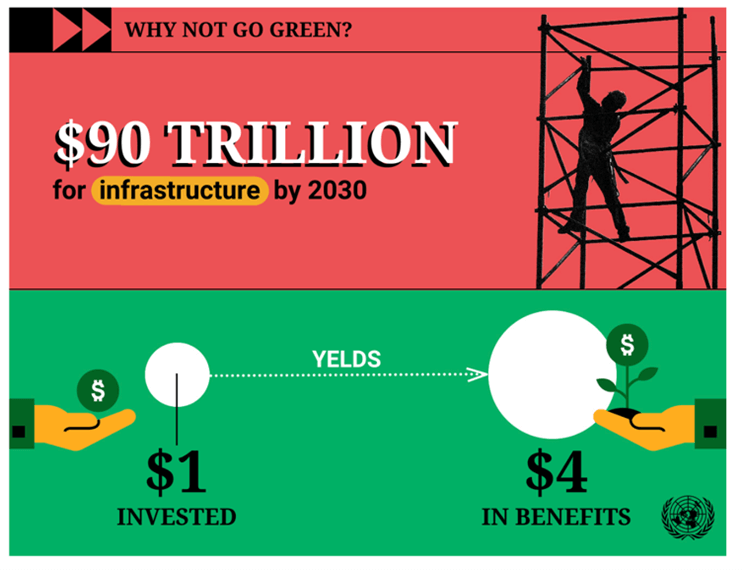
Therefore although we hear much about the cost of dealing with climate change, it’s wrong to say that the cost of acting to keep temperatures down is too much. In fact, it’s the other way around: if we act now we could be better off, globally, and if we delay action, dealing with climate change will cost us much more in the long run.
The short answer to this great question is: not as much as we’ll need to invest if we don’t make a drastic change! In the past, the cost of changing the way we do things has been used as an argument for not acting on climate change, but there are costs on both sides of that argument (that is, there is a cost to acting but there is also a cost to not acting). Climate change is making disasters like extreme bushfires and droughts more common, and these kinds of disasters already cost Australians a lot (approx. $3 trillion from 2010-2019!). These costs, which relate to damage and lost income, are going to increase a lot if we do not take urgent action on climate change.
Some people have tried to estimate how much money the world would need to spend to stop climate change, and their estimates range from $300 billion (the cheapest option!) to $50 trillion! Both of these amounts are huge and hard to imagine. The big difference between the cheapest and most expensive estimates also show us that working out exactly how much investment is required is a really hard maths problem! It’s hard because the final cost will depend on lots of things, like whether people agree on what to do, who should do it, and when, but also on how quickly we all make the drastic changes that are needed. For example, we know we need to shift from using fossil fuels to renewable energy, but the cost of doing it quickly (which might include governments paying some of the costs for people to install solar power, big batteries and other renewable options at their homes) might be really different from making that change slowly (which might mean that companies and governments waste money building or upgrading fossil fuel buildings that they can’t use because fossil fuels are banned).
Importantly, we need to remember that money we spend now to get ready for the challenges of climate change will benefit young people alive today and all of the people that come after us, as well as natural systems like our coasts and beaches, wetlands and forests. Investing in drastic change is definitely ‘worth it’, because this is an investment for all of us, and for our children’s children, and for the places that we love the most.
We are using modern technology to combat climate change, but not to its full potential (yet). There is still more that could be achieved with solar power technology, batteries, alternatives to plastics and recycling, among many other things. Some exciting and innovative new ideas include paint that can convert energy from the sun – which could then be used on roads or on houses.
There are also efforts underway to produce fully biodegradable plastic alternatives, from seaweed or plant fibres. We also have a lot of exciting development happening in electric cars and infrastructure for solar charging stations. This will all help us move away from a reliance on fossil fuels, which is the main cause of climate change.
As well as helping us to reduce the causes of climate change, modern technologies can also help us to adapt to the changes climate change will bring. We can use models and satellites to predict extreme events ahead of time so we can plan ways to reduce the impacts. Farmers can use technology to help them plant crops more suited to future climate. We can also use technology to build houses that are more energy efficient, and plan new developments in ways that take into account climate change.
Modern technology is a useful part of our response to climate change, but we also https://www.youtube.com/watch?v=Ci6LKz0ajfI&t=7sneed to do other things too, like reducing our consumption (see Curious Climate Schools what can I do?). Climate change needs a range of responses, we can’t rely on technology alone.













